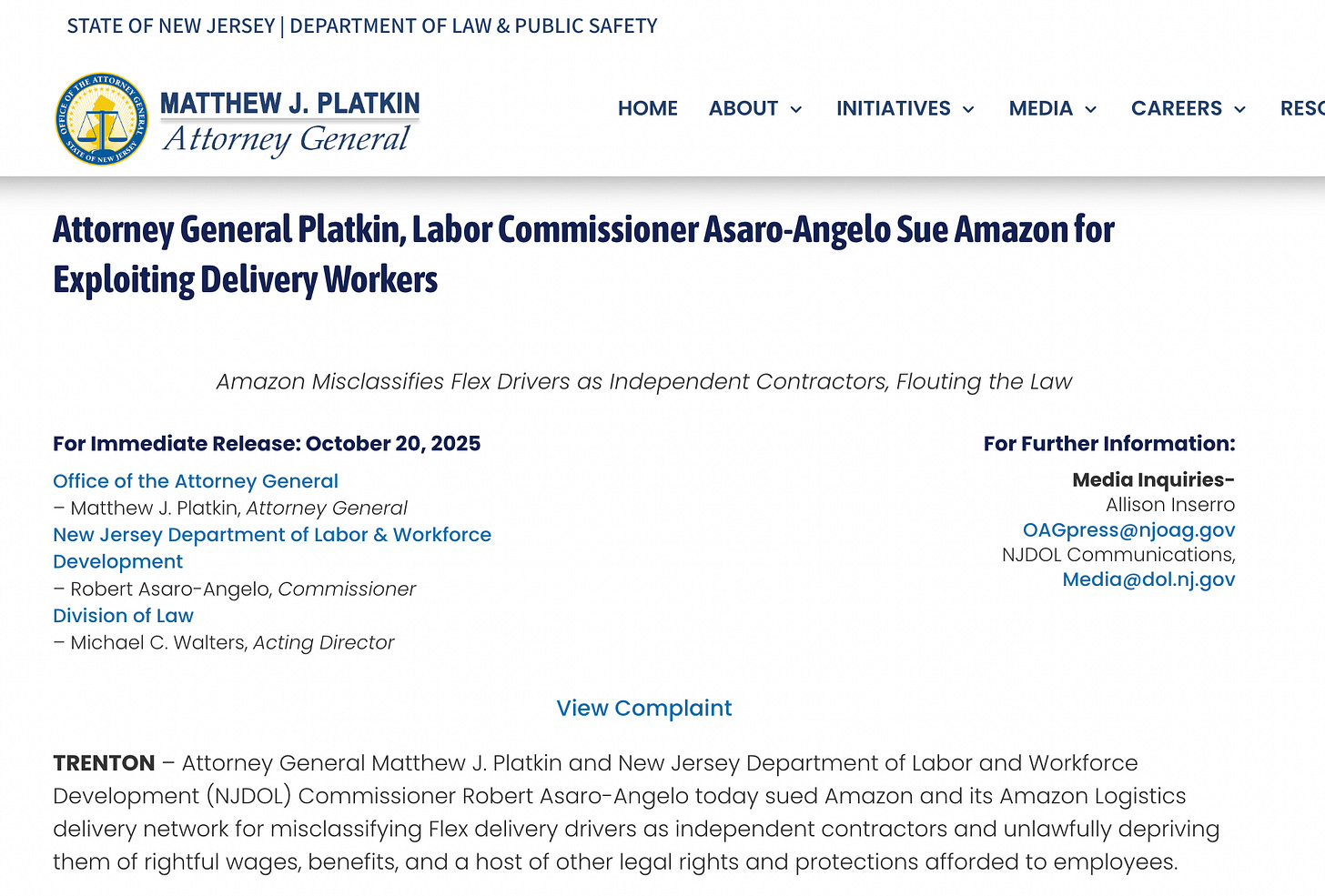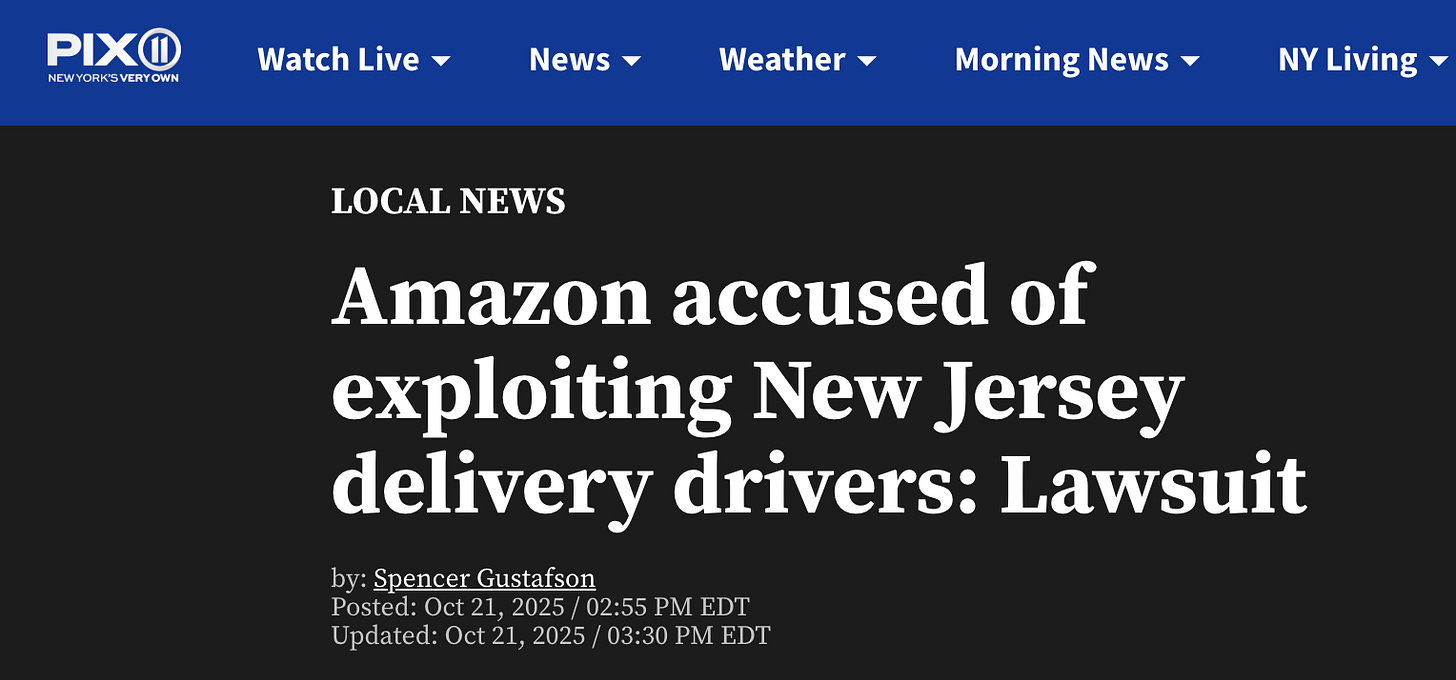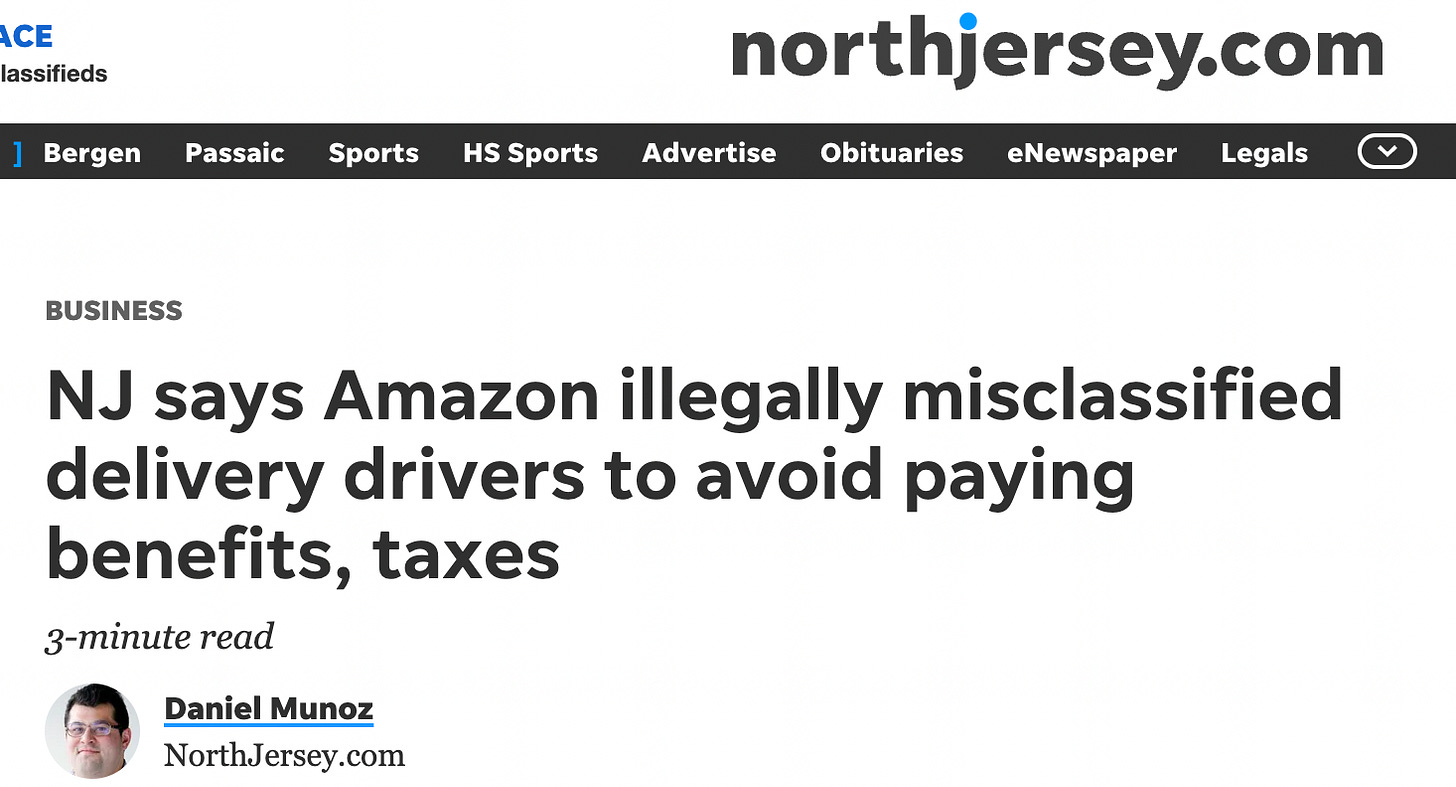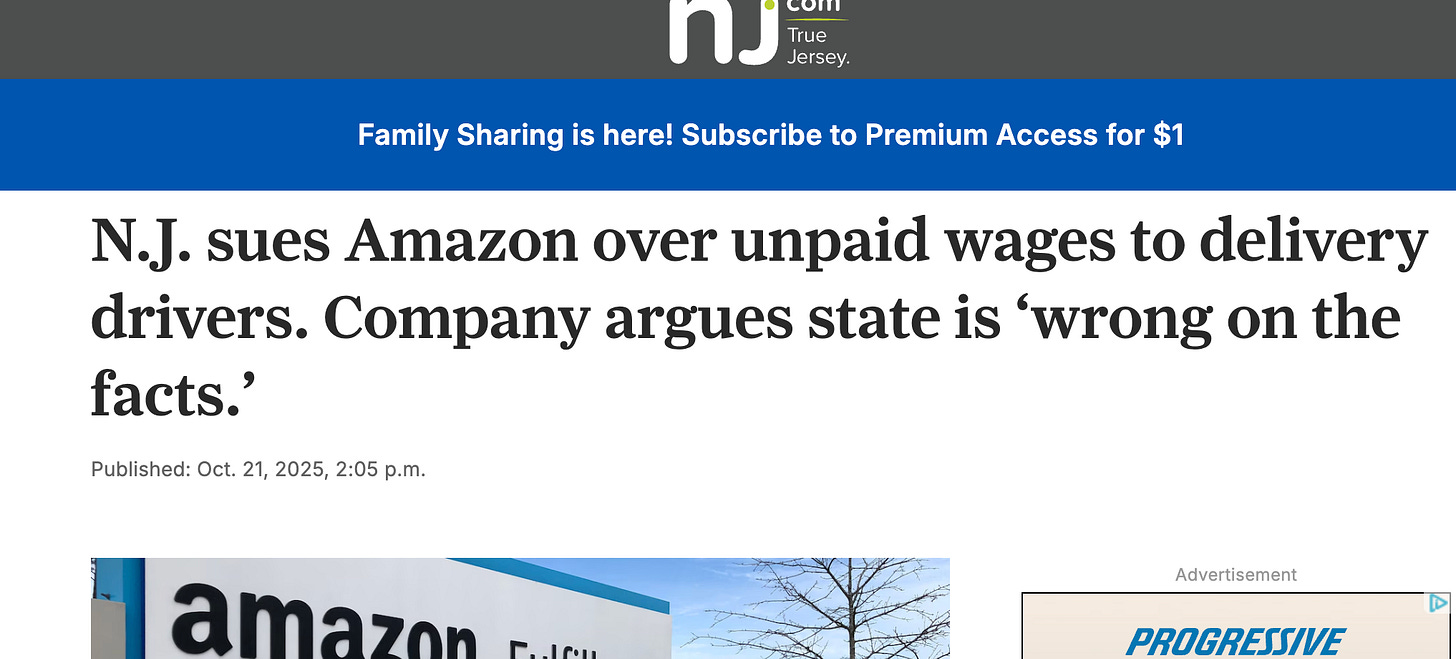Quite the Show
New Jersey's lawsuit against Amazon is the lead story, but several plot twists are in the timing, the press release and a related public comment.
On Monday, New Jersey Attorney General Matthew Platkin and Labor Commissioner Robert Asaro-Angelo announced that they had sued Amazon and the Amazon Logistics delivery network, claiming that Flex delivery drivers are misclassified independent contractors who should be employees.
An Amazon spokesperson told NJ Advance Media the lawsuit is “wrong on the facts and the law, and misrepresents what Amazon Flex is and how it works.”
I’m not going to write about the lawsuit’s allegations, since they’re only one side of the case, and more will surely play out in court.
But I do think it’s important to discuss a few other things, including the significance of the lawsuit’s timing, its relationship to the Labor Department’s current public-comment process about a proposed independent-contractor rule, and serious questions that the state’s press release raises.
News of the lawsuit broke at the same time that New Jersey’s Department of Labor & Workforce Development is proposing rule-making that would affect an estimated 1.7 million independent contractors in hundreds of professions—rule-making that is facing 99% public opposition in a deluge of about 9,500 written comments.
Filing this lawsuit right now is a move that, from a media perspective, lets the Labor Department attempt to reposition itself as a hero instead of a villain.
In the state’s press release about this lawsuit, the Labor Department holds itself out as a champion of “dignity and respect” for Flex drivers—again, at the same time that nearly everyone who filed a public comment, including a lot of app-based drivers, is saying the Labor Department’s way of thinking about independent contractors is harmful.
For months now, ever since a standing-room-only public hearing packed with 3-to-1 opposition in June, Governor Phil Murphy and his Labor Department have been on the defensive:
News 12 New Jersey and NJBIZ questioned Murphy directly on at least three separate occasions.
The New Jersey Business & Industry Association and NJ101.5 radio have repeatedly hammered this proposed rule.
The New Jersey Chamber of Commerce—in conjunction with 159 local and regional chambers, including the African American Chamber of Commerce, the New Jersey State Women’s Chamber of Commerce, the New Jersey Pride Chamber of Commerce and the New Jersey State Veterans Chamber of Commerce—wrote that what the Labor Department is attempting to do goes “far beyond reasonable regulation” and “will disqualify a wide range of legitimate independent contractor relationships across dozens of industries.”
Two dozen sitting legislators on both sides of the political aisle have raised their voices in concern, including three who are preparing legislation that would overturn the rule.
The state’s own Office of the Public Defender is urging the Labor Department to withdraw its proposed independent-contractor rule, writing that: “Court calendars will be delayed, clients will wait longer for representation, and constitutional mandates will be jeopardized.”
This week’s lawsuit announcement silenced all that opposition and more, at least temporarily. Here’s what New Jersey media, and New York media that reaches a New Jersey audience, are now focusing on instead:
Amazon.
Amazon.
Amazon.
The words “Labor Department” aren’t even in the headlines anymore.
I’ve written in the past about how, when the freelance busters talk about wanting regulatory crackdowns on Uber and Lyft, they really mean they want restrictions placed on all independent contractors. They say “Uber” and “Lyft” as many times as they can, though, because if they can make those companies the central characters in the narrative, then nobody thinks about the broader consequences of what it means to restrict everyone’s freedom to be our own bosses.
In this context, Amazon is the same as Uber and Lyft. A mere mention of Amazon is enough, in this policy area, to flip the media script as fast as changing a TV channel.

For another example of how this tactic is in play right now at New Jersey’s Labor Department, let’s take a look at the claims Make the Road New Jersey presented in its public comment about the proposed independent-contractor rule.
The ‘Mega-Corporation’ with an ‘Army’
Make the Road New Jersey’s written public comment supports the proposed rule that targets independent contractors across hundreds of professions, but the organization’s arguments are almost entirely about Amazon—which the comment describes as a “Washington-based mega-corporation set to become the largest retailer in the country” with a “growing army of on-demand, independent contractor Flex drivers.”
This comment names Amazon 35 times in its 15 pages. It mentions Amazon Flex specifically more than 25 times. (And even more than that if you count the footnotes.) It also incorporates letters from two people who say they are Amazon Flex drivers. And it throws in “Uber” and “Lyft” a couple times, too.
You can read the 15-page comment in full here:
Make the Road New Jersey, according to InfluenceWatch, is part of Make the Road States, a multimillion-dollar nonprofit based in Brooklyn, N.Y. Make the Road New Jersey’s staff is organized with the United Auto Workers Union 2320, the same union that represents workers at the multimillion-dollar, union-aligned think tank National Employment Law Project.
Until the beginning of this year, Make the Road New Jersey’s executive director was Sara Cullinane, a former union organizer who served on Governor Murphy’s transition team. Make the Road New Jersey’s current executive director is Nedia Morsy, whose recent research includes studying “right-of-center organizing strategies.”
Make the Road New Jersey’s public comment is crystal-clear about why the organization has such a beef with Amazon: The business model of working with independent contractors instead of unionized drivers in the Amazon Flex program.
The comment states:
“Amazon’s Flex program is the epitome of a scalable program that erodes labor standards and increases the power imbalance between employers and employees by eradicating worker bargaining power—this in exchange for profit increases and the ability to better shape and control legal liability. When Amazon unveiled the Flex program in 2015, two-thirds of its delivery fleet were unionized UPS drivers. One year later, the independent contractor—and thus National Labor Relations Act exempt—Flex drivers handled 10% of the corporation’s deliveries and by just 2020, they had largely replaced the unionized UPS drivers and handled two-thirds of Amazon’s last-mile deliveries.”
This description implies that things were better at Amazon Flex when the people delivering packages were unionized UPS drivers, as if those drivers were happy with their situation.
But in 2023, there was a big public brouhaha involving UPS drivers and their union contract negotiations. It churned up complaints these unionized workers had been making for years.
CBS News reported at the time:
“A tentative agreement between UPS and its unionized workforce has been hailed as ‘historic,’ with Teamsters leadership boasting that they ‘changed the game.’
“President Biden congratulated contract negotiators and shipping customers everywhere, breathing a sigh of relief that a massive strike would likely be averted. The agreement boosts starting pay for part-timers to $21 an hour, raises the top rate for full-time drivers to $49, eliminates a hated ‘two-tier’ wage system that paid some drivers less than others for identical work and includes heat protections and air conditioning for new trucks.
“But the deal must still be ratified by UPS’ 340,000 unionized workers, most of whom are part-time, and some of whom say it wouldn’t fix decades of falling pay in a physically exhausting job. Those workers are calling for a ‘no’ vote on the agreement, raising the possibility that ratification will fail.
“‘A lot of us are frustrated and disappointed,’ said Jose Francisco Negrete, a package handler in Anaheim, California, who has been working at UPS for 25 years. Negrete, who also works part-time as a classroom assistant, is part of a contingent of workers pushing for a $25 hourly minimum for part-timers.
“‘$21 is still poverty pay — it’s $1.50 more than the In-N-Out, which is a two-minute drive away,’ he said. ‘Is that really going to move the needle for you? Are you still going to be working two or three jobs? Are you still going to be on government assistance?’”
Amazon Flex, according to Make the Road New Jersey’s public comment, says drivers can expect to earn $15 to $25 per hour.
As independent contractors, these drivers pay for their own expenses such as gas, but they do not pay dues to any union.
16 Hours is a Long Time
While reading this public comment that Make the Road New Jersey filed about Amazon Flex, I actually shook my head a few times, and then went back and reread a passage just to make sure I hadn’t missed something.
The best example is this passage on page 11 of the comment:
“One Flex driver in New Jersey said out of 24 hours of the day, she spends 16 hours just looking for a delivery block on the Amazon Flex application. This unpaid time on the clock, looking for work to pay the bills in this gig economy, would be compensable under local, state, and federal wage and hour laws.”
It sounded awfully strange to me that a person looking for work would spend 16 hours a day on an app where there’s no work to be found.
The footnote in Make the Road New Jersey’s comment says this claim comes from this NELP research, which in turn says this New Jersey Flex driver is named Angela. A footnote in the NELP research says Angela had a conversation in September 2024 with NELP’s own Maya Pinto (who testified at New Jersey’s public hearing in June, and who previously was with the Service Employees International Union).
That is all the information we are given about Angela. We don’t even know her last name. And it’s unclear why, if she’s looking for work, she doesn’t spend at least some of her 16 hours a day looking for work on, say, another app.
On the other hand, the two Amazon Flex drivers whose letters are part of Make the Road New Jersey’s public comment seem to be finding plenty of work through the Flex app, but they aren’t happy with their situations either.
There’s first-name-only Omary, who writes that Amazon “limit[s] me to a maximum of eight hours per day and 40 hours per week, and I cannot accept more blocks even if I have availability.”
It’s unclear why Omary doesn’t pick up gigs on other apps, or do part-time or salaried work of another nature, if he wants to work more than 40 hours a week.
And there’s Esther Nuñez, who seems to wish she worked someplace other than Amazon altogether:
“Amazon work is both mentally and physically exhausting, and without any structure or job security, I’m forced to juggle multiple income sources just to survive. I would much rather have a single stable job with benefits, where I don’t have to constantly rearrange my entire life around a volatile, unpredictable gig schedule.”
It’s also unclear why Esther is unable to apply for the kind of traditional job it appears that she would prefer.
Angela, Omary and Esther are three of the four Amazon Flex drivers that Make the Road New Jersey cites by name in this public comment. The fourth is Patricia Hearons, who is described as “a Flex driver and member of the Philadelphia Drivers’ Union who testified at a 2021 Pennsylvania State Senate hearing on independent contractor misclassification.”
The comment cites this 2021 testimony from Hearons:
“I know friends who are actual contractors, and when they have to do more work, they get paid more—they change their rates. We have no negotiating power. So, misclassification is wage theft.”
That’s all the comment says about Hearons, but there is more to her story.
In 2022, the year after she gave that testimony, Hearons wrote an op-ed that ran in the Philadelphia Inquirer. She wrote about how she took on driving not just for Amazon Flex, but also for DoorDash, “while trying to change careers [with] health issues and caregiving duties.”
Her op-ed is clear about her frustration with app-based work, but it also suggests that in her case, the industry turned out to be a bridge to that new career she wanted.
The tagline at the end of her op-ed says she was transitioning into the tech industry after years in neuroscience research and data migration and validation.
Yes, They Added the 61 Cents
Make the Road New Jersey’s public comment, of course, also begs the question of why any rule-making is needed at all for the state’s Labor Department to accuse Amazon Flex of employee misclassification, which the Department just did in court this week, without the rule being finalized.
In addition to that question, the State of New Jersey’s press release about the lawsuit raises several additional, significant questions.
First, this press release makes clear that even when regulators spend years targeting what they claim is a widespread problem of employee misclassification, they can’t seem to find nearly as much of it as they allege exists.
This press release says that since 2020, after all the intense focus the Murphy administration has placed on misclassification—including the creation of a task force, the enactment of 10 new laws, the creation of a new government agency office, and the granting of first-of-its-kind power to the Labor Commissioner—the result includes an average of only $827 apiece having been returned to just 13,567 workers.
Now, the press release does also cite multimillion-dollar settlements that Uber and Lyft paid to the state over misclassification allegations, but the reality is that Uber and Lyft never conceded their drivers were misclassified. They’re still independent contractors. The companies paid the fines to resolve the state’s complaints.
Arguably, the companies chalked up these fines ($100 million for Uber, and $19.4 million for Lyft) as a cost of running their multibillion-dollar businesses in New Jersey. That could happen with Amazon too, given that the company is worth trillions.
And, while it’s of course a good thing if misclassified New Jerseyans are receiving money they were owed but never paid, it’s also a plain fact that the 13,567 individuals the Labor Department says had money come directly back to them are not even close to 1% of New Jersey’s total workforce that the Department is supposed to be representing.
The State of New Jersey itself seems to realize how paltry this result appears on paper, since the press release describes the average of $827 per person as “$11,223,560.61 for 13,567 workers.”
Yes, they tacked that extra 61 cents on at the end, an old-school trick to make any figure appear bigger on paper.
Last—and following the Murphy administration’s documented history of citing mischaracterized data and research in this policy area—the press release further describes the reason for the Labor Department’s vigorous fight against misclassification by presenting an estimate about how much money the problem is costing New Jersey taxpayers.
The press release states:
“The Century Foundation estimates that in 2021, New Jersey taxpayers lost $329.3 million from worker misclassification, including lost unemployment insurance contributions, Social Security and Medicare contributions, and federal and state income taxes.”
Ahem.
That Century Foundation estimate is from a report you can read here. It’s about the construction industry. The $329.3 million figure is in the downloadable state-by-state cost estimates beneath Map 2.
Make sure you read the methodology section, as well. Century Foundation researchers say they used methodology based on a 2020 study I wrote about here. The Century Foundation describes this 2020 study as “being headlined by scholars,” but if you read it, you’ll see it’s actually commissioned research that’s supported by the United Brotherhood of Carpenters and the union-affiliated group ICERES.
Its own authors noted that:
“… this study makes no claim about the relative size of off-the-books employment versus worker misclassification in these results. The data simply does not allow for definitive classification of workers into either of these two groups. While it is tempting to consider those who claim to be employed despite not showing up on company payrolls as ‘misclassified workers,’ the 2002 report by an analyst at the U.S. Census Bureau revealed that these individuals also feature a large number of off-the-books workers. While conversations with industry stakeholders have consistently suggested that off-the-books employment dwarfs worker misclassification, the lack of distinction between the two types of workers in the data leaves us without sufficient empirical standing to evaluate these claims.”
That is quite the methodology for the Murphy administration to hang its hat on when attempting to justify its aggressive freelance-busting stance.
For now, that stance shows no sign of changing. The Labor Department is pushing its preferred narrative out to the press, filing a lawsuit against another app-based company, and refusing to rescind its proposed independent-contractor rule that targets us all.
Maybe if all of us freelance writers, financial advisers, insurance agents, attorneys, translators, interpreters and other independent contractors go outside, spin around on our heels and say “Amazon” three times, the proposed independent-contractor rule will simply disappear.





